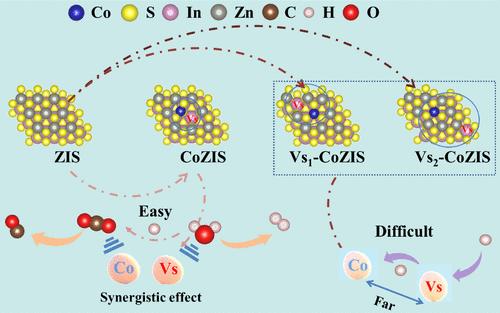利用ZnIn2S4中相邻的Co金属和硫空位双位点促进可见光光催化合成气生产
IF 13.1
1区 化学
Q1 CHEMISTRY, PHYSICAL
引用次数: 0
摘要
太阳能驱动的二氧化碳转化为合成气(CO/H2)代表了一种有前途的碳中性燃料合成方法。然而,由于析氢反应(HER)的竞争以及对活性位点分布的空间控制不足,实现高效和选择性的光催化CO2还原仍然具有挑战性。本文中,我们引入了一种共掺杂ZnIn2S4 (CoZIS)光催化剂,其中Co掺杂诱导形成相邻的Co金属位和硫空位(Vs),建立空间协调的双活性位。这种结构可以通过d-p轨道杂化和相邻v上的质子还原,在Co位点选择性地吸附和活化CO2,从而促进质子耦合电子转移(PCET)和促进*COOH中间体的形成。优化后的CoZIS在可见光照射下的合成气产率为1314.8 μmol g-1 h-1,超过了许多类似硫化物基光催化剂的产率。原位光谱研究、动力学同位素效应(KIE)实验和密度泛函理论(DFT)计算表明,Co和Vs位点的接近降低了*COOH形成能垒,同时提高了电荷分离效率。这项工作提出了一种通用的掺杂剂缺陷工程策略,用于创建协调二氧化碳和质子还原的协同双位点,为合成气生产和碳回收技术提供了广泛的影响。本文章由计算机程序翻译,如有差异,请以英文原文为准。

Boosting Visible-Light Photocatalytic Syngas Production via Spatially Adjacent Dual Sites of Co Metal and Sulfur Vacancy in ZnIn2S4
Solar-driven conversion of CO2 to syngas (CO/H2) represents a promising approach for carbon-neutral fuel synthesis. However, achieving efficient and selective photocatalytic CO2 reduction remains challenging due to competition from the hydrogen evolution reaction (HER) and inadequate spatial control over active site distribution. Herein, we introduce a Co-doped ZnIn2S4 (CoZIS) photocatalyst, where Co doping induces the formation of adjacent Co metal sites and sulfur vacancies (Vs), establishing spatially coordinated dual active sites. This architecture enables selective CO2 adsorption and activation at Co sites via d-p orbital hybridization coupled with proton reduction at neighboring Vs, thereby promoting proton-coupled electron transfer (PCET) and facilitating *COOH intermediate formation. The optimized CoZIS delivers a syngas production rate of 1314.8 μmol g–1 h–1 under visible-light irradiation, surpassing reported yields for many analogous sulfide-based photocatalysts. In-situ spectroscopic studies, kinetic isotope effect (KIE) experiments, and density functional theory (DFT) calculations demonstrate that the proximity of Co and Vs sites reduces the *COOH formation energy barrier while improving the charge separation efficiency. This work advances a versatile dopant-defect engineering strategy for creating synergistic dual sites that orchestrate CO2 and proton reduction, offering broad implications for syngas production and carbon recycling technologies.
求助全文
通过发布文献求助,成功后即可免费获取论文全文。
去求助
来源期刊

ACS Catalysis
CHEMISTRY, PHYSICAL-
CiteScore
20.80
自引率
6.20%
发文量
1253
审稿时长
1.5 months
期刊介绍:
ACS Catalysis is an esteemed journal that publishes original research in the fields of heterogeneous catalysis, molecular catalysis, and biocatalysis. It offers broad coverage across diverse areas such as life sciences, organometallics and synthesis, photochemistry and electrochemistry, drug discovery and synthesis, materials science, environmental protection, polymer discovery and synthesis, and energy and fuels.
The scope of the journal is to showcase innovative work in various aspects of catalysis. This includes new reactions and novel synthetic approaches utilizing known catalysts, the discovery or modification of new catalysts, elucidation of catalytic mechanisms through cutting-edge investigations, practical enhancements of existing processes, as well as conceptual advances in the field. Contributions to ACS Catalysis can encompass both experimental and theoretical research focused on catalytic molecules, macromolecules, and materials that exhibit catalytic turnover.
 求助内容:
求助内容: 应助结果提醒方式:
应助结果提醒方式:


